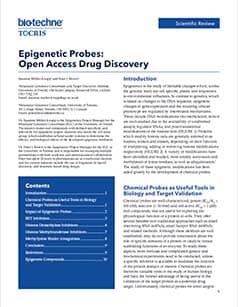Histone Deacetylases
There are 18 Histone Deacetylase (HDAC) enzymes that are classified into two groups, the histone deacetylase family and the sirtuin family. The histone deacetylase family is divided into classes I, II and IV.
Histone Deacetylase Target Files
There are 18 Histone deacetylases (HDAC) enzymes that are classified in to two families, the histone deacetylase family and the sirtuin family. The histone deacetylase family is further divided in to class I (HDACs 1/2/3 and 8), class II (HDACs 4/5/6/7/9/10) and class IV (HDAC 11). The sirtuin family are all classified as class III HDACs. HDACs catalyze acetyl group removal from lysine residues in histones and non-histone proteins, causing transcriptional repression. In general, they do not act autonomously but as components of large multiprotein complexes, such as pRb-E2F and mSin3A, that mediate important transcription regulatory pathways.
Classes I, II and IV, are closely related Zn2+-dependent enzymes, which are ubiquitously expressed and they can exist in the nucleus or cytosol. Their subcellular localization is affected by protein-protein interactions (for example HDAC-14.3.3 complexes are retained in the cytosol) and by the class to which they belong (class 1 HDACs are predominantly nuclear whilst class 2 HDACs shuttle between the nucleus and cytosol). HDACs have a role in cell growth arrest, differentiation and death and this has led to substantial interest in HDAC inhibitors as possible antineoplastic agents.
Histone acetylation - a key epigenetic process - is upregulated during memory formation but downregulated in numerous neurodegenerative diseases, such as Alzheimer's disease and Huntington's disease. As a result, HDAC inhibitors are also of great interest in neuroscience research.
Literature for Histone Deacetylases
Tocris offers the following scientific literature for Histone Deacetylases to showcase our products. We invite you to request* your copy today!
*Please note that Tocris will only send literature to established scientific business / institute addresses.
Huntington's Disease Research Product Guide
This product guide provides a background to Huntington's disease research and lists around 100 products for the study of:
- Somatic Instability
- Proteolysis and Inclusion Bodies
- Transcriptional Dysregulation
- Mitochondrial Dysfunction
- Nuclear-Cytoplasmic Transport Interference
- Excitotoxicity
- Stem Cells
Epigenetics Scientific Review
Written by Susanne Müller-Knapp and Peter J. Brown, this review gives an overview of the development of chemical probes for epigenetic targets, as well as the impact of these tool compounds being made available to the scientific community. In addition, their biological effects are also discussed. Epigenetic compounds available from Tocris are listed.
Depression Poster
Major depressive disorder is characterized by depressed mood and a loss of interest and/or pleasure. Updated in 2015 this poster highlights presynaptic and postsynaptic targets for the potential treatment of major depressive disorder, as well as outlining the pharmacology of currently approved antidepressant drugs.
Rheumatoid Arthritis Poster
Rheumatoid arthritis (RA) is a chronic destructive inflammatory autoimmune disease that results from a breakdown in immune tolerance, for reasons that are as yet unknown. This poster summarizes the pathology of RA and the inflammatory processes involved, as well as describing some of the epigenetic modifications associated with the disease and the potential for targeting these changes in the discovery of new treatments.
Histone Deacetylase Gene Data
| Gene | Species | Gene Symbol | Gene Accession No. | Protein Accession No. |
|---|---|---|---|---|
| Class 1 | ||||
| HDAC1 | Human | HDAC1 | NM_004964 | Q13547 |
| Mouse | Hdac1 | NM_008228 | O09106 | |
| Rat | Hdac1 | NM_001025409 | Q4QQW4 | |
| HDAC2 | Human | HDAC2 | NM_001527 | Q92769 |
| Mouse | Hdac2 | NM_008229 | P70288 | |
| Rat | Hdac2 | NM_053447 | Q99PA1 | |
| HDAC3 | Human | HDAC3 | NM_003883 | O15379 |
| Mouse | Hdac3 | NM_010411 | O88895 | |
| Rat | Hdac3 | NM_053448 | Q6P6W3 | |
| HDAC8 | Human | HDAC8 | NM_018486 | Q9BY41 |
| Mouse | Hdac8 | NM_027382 | Q8VH37 | |
| Rat | Hdac8 | NM_001126373 | XP_343805 | |
| Class 2 | ||||
| HDAC4 | Human | HDAC4 | NM_006037 | P56524 |
| Mouse | Hdac4 | NM_207225 | Q6NZM9 | |
| Rat | Hdac4 | XM_343629 | Q99P99 | |
| HDAC5 | Human | HDAC5 | NM_001015053 | Q9UQL6 |
| Mouse | Hdac5 | NM_001077696 | Q9Z2V6 | |
| Rat | Hdac5 | XM_001081495 | Q5RJZ2 | |
| HDAC6 | Human | HDAC6 | NM_006044 | Q9UBN7 |
| Mouse | Hdac6 | NM_010413 | Q9Z2V5 | |
| Rat | Hdac6 | XM_228753 | Q99P97 | |
| HDAC7 | Human | HDAC7 | NM_016596 | Q9UFU7 |
| Mouse | Hdac7 | NM_019572 | Q8C2B3 | |
| Rat | Hdac7a | XM_345868 | Q99P96 | |
| HDAC9 | Human | HDAC9 | NM_058177 | Q9UKV0 |
| Mouse | Hdac9 | NM_024124 | Q99N13 | |
| HDAC10 | Human | HDAC10 | NM_032019 | Q969S8 |
| Mouse | Hdac10 | NM_199198 | Q6P3E7 | |
| Rat | Hdac10 | NM_001035000 | Q569C4 | |
| Class 4 | ||||
| HDAC11 | Human | HDAC11 | NM_024827 | Q96DB2 |
| Mouse | Hdac11 | NM_144919 | Q91WA3 | |
| Rat | Hdac11 | NM_001106610 | XP_238362 | |



